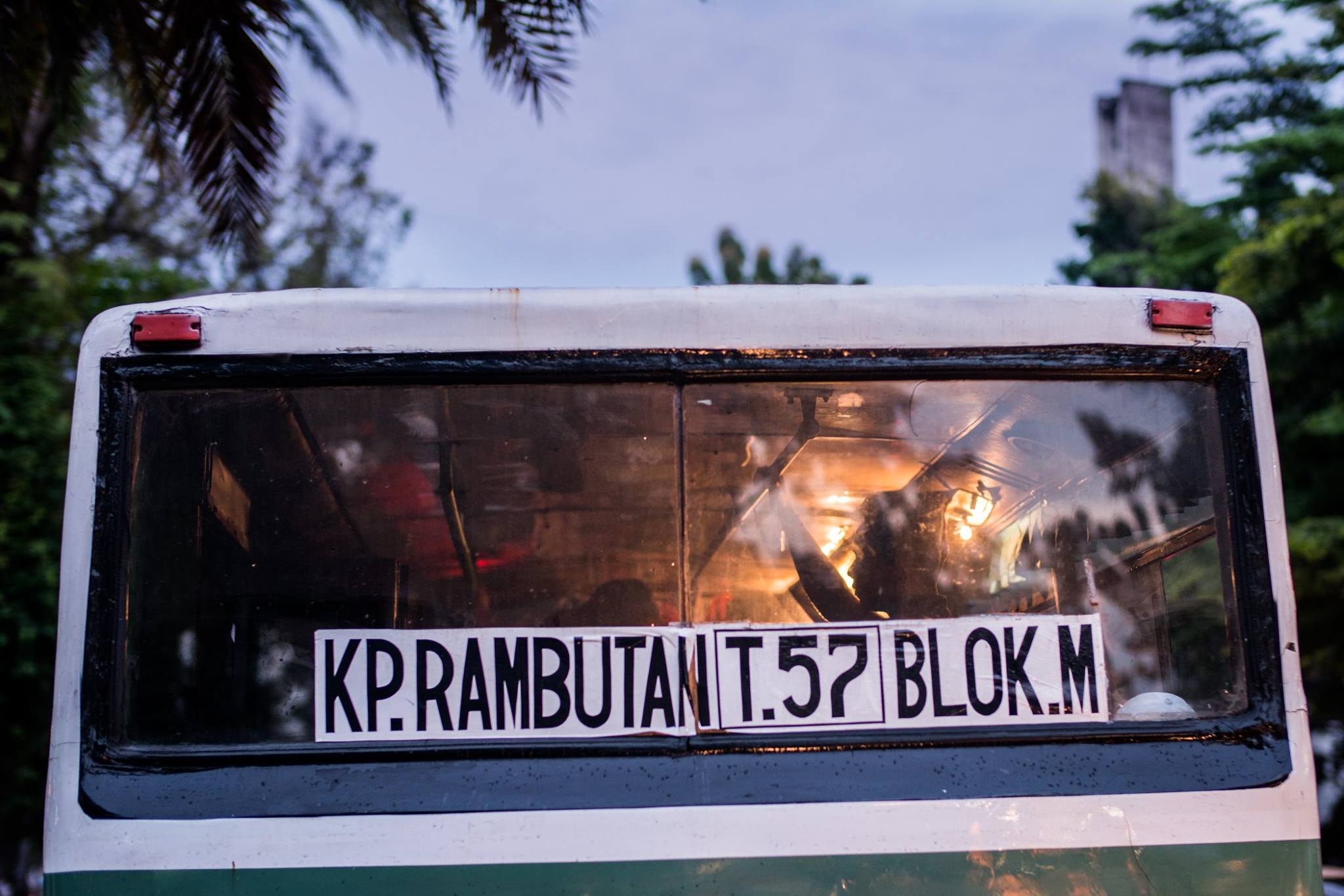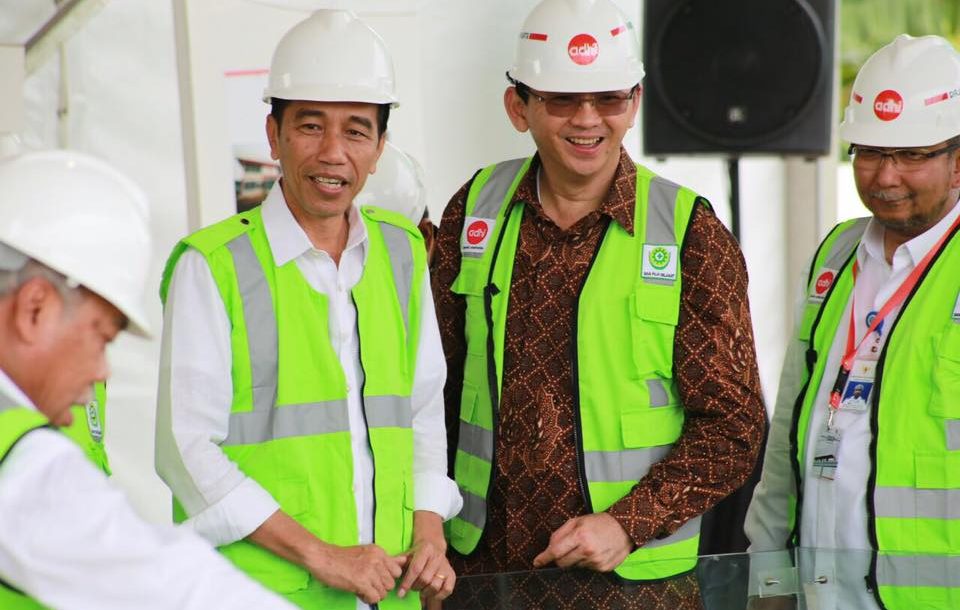The discussion about Jakarta’s 2017 gubernatorial election has mainly been about identity politics, religion, and the role of minorities in electoral politics. One important aspect that has not been covered as much is development policy.
A lot of criticism was directed at outgoing Governor Basuki Tjahaja Purnama, or Ahok, for giving preference to the interests of private conglomerates. According to Ian Wilson, Ahok was close to conglomerates such as the Agung Podomoro Group, Agung Sedayu Group or Sinarmas Group. Critics point out his close relationship with those big businesses, while highlighting how at the same time he marginalised Jakarta’s poor. There was even a joke that Ahok is not the Governor of Jakarta but the ‘governor [for] Agung Podomoro’. Ahok’s policies, such as the reclamation projects in Jakarta Bay, supposedly advantaged property-based conglomerates, exemplified by Agung Podomoro.
But did Ahok really defend big companies as much as his critics said? Which companies gained the most benefits from the governor’s policies? Differing from most of Ahok’s critics and their main assumptions, my research has found that the biggest beneficiaries of Ahok’s governorship have been state-owned enterprises, both those owned by national government (Badan Usaha Milik Negara, or BUMN) or by regional government (Badan Usaha Milik Daerah, or BUMD). Ahok facilitated and favoured state-owned enterprises, continuing what his predecessor as governor, Jokowi, had already done. Several critics have pointed out the ‘neoliberal’ policy of Ahok in managing Jakarta. However, my research demonstrates that he promoted a state-led, rather than market-based, development agenda.

The rise of state capitalism
Continuing the policy of the previous governor, Jokowi, Ahok has relied not only on the bureaucracy but also the businesses owned by the Jakarta provincial government (hereafter referred to by their Indonesian acronym, BUMD). The governors made savings in the budget spending and used the remaining funds for capital injections to BUMD. In the fiscal years 2013–2015, capital injections into these companies from the provincial budget amounted to more than Rp12.72 trillion (A$1.2 billion)—far greater than during Fauzi Bowo’s administration, which between the fiscal years 2007–2012 allocated just Rp1.12 trillion (A$111 million). The Jakarta government’s total equity in all its BUMD stands at around Rp20 trillion (A$2 billion). If Forbes magazine’s rich list was not limited to recording individual private wealth, the Jakarta government would surely be in its top ranks.
As governor, both Jokowi and Ahok managed the BUMD as they did the bureaucracy. They recruited directors from among the best managers through open recruitment and closely monitored their performance. As soon as these directors failed to achieve targets, the governor would replace them with other professional managers.
In 2016, for instance, Ahok recruited Budi Kaliwono to become the head of bus operator Transjakarta to replace the previous director, who could not achieve his targets. Budi was a former top executive of Cipaganti, a well-known private transportation company. Ahok also recruited Kresno Sediarsi, the former technology and operations director of Bank Mandiri (Indonesia’s biggest state-owned bank) to become the President Director of Bank DKI, a bank owned by the Jakarta government. Ahok wanted not just to transform Bank DKI into a bigger market player, but also have it provide the infrastructure for cashless transactions in Jakarta public services.
From a governor’s perspective, there are several advantages to using BUMD as instruments of development policy. He can implement development projects faster than if using the bureaucracy—especially in regards to tender procedures. SOEs, either nationally or regionally-owned, are allowed to use their own internal tender regulations, but the regional bureaucracy must use nationally-set regulations on public tenders that are more complex and time-consuming. Furthermore, BUMD are administratively situated directly under the governor. He can recruit and replace their directors at any time, whereas when dealing with the bureaucracy the Governor must follow national regulations. Governors can recruit the best managers on the market to be directors of BUMD, but can only recruit the heads of departments (Dinas), or make other high ranking bureaucratic appointments, from within the existing ranks of public servants.
The management of Jakarta’s Bus Rapid Transport or ‘busway’ system is a good case study. Previously, the Jakarta government managed the busway directly through the bureaucracy by establishing a dedicated agency within the Department of Transportation (Dinas Perhubungan). The operators were private companies, which contracted with the agency. Under Jokowi’s governorship, however, busway management was transferred to a BUMD, Transjakarta, which was specifically incorporated to serve as the busway operator. The government revoked its contracts with the private sector. By the end of 2016, Transjakarta owned and managed 1,022 buses, with a target to buy and manage 2,590 buses by the end of 2017.
Transjakarta quickly took over a dominant role in Jakarta’s transportation sector. Previously, the sector was dominated by private business, with the government managing it through regulations and the issuance of permits. Now the Jakarta government controls the market itself through Transjakarta, while setting higher service standards in its simultaneous role as regulator. Private transportation operators in Jakarta are now in a difficult period—especially the Metromini or mikrolet services, which are mostly small personal businesses. There are no options left for the private sector other than to partner with Transjakarta as a feeder service, or to close down their businesses.
Overall, both Governor Jokowi and Ahok led Jakarta followed a state-led development model. The government directly managed public services that had previously been contracted out to the private sector. The government’s primary instrument in implementing its rational–technocratic planning was not only the bureaucracy, but also the SOEs, which ceased to be merely business units, but also agents of development.

SOEs and large infrastructure projects
To understand how Jakarta’s SOEs operate in, and benefit from, Ahok’s policies, let’s turn to several large infrastructure projects in Jakarta. Some SOEs are big companies, which mostly bid on big projects. In some businesses, these large SOEs are competing directly with the private conglomerates—and the interests of the oligarchs who control them.
Take the controversial reclamation in Jakarta Bay. Several private conglomerates obtained concessions to develop the reclaimed land. Subsidiaries of big private business groups, particularly Kapuk Naga Indah and Muara Wisesa Samudra, have started their reclamation. Kapuk Naga Indah is a subsidiary of Agung Sedayu Group, a developer belonging to Sugianto Kusuma (also known as Aguan) and his colourful business partner Tommy Winata. Muara Wisesa Samudra, meanwhile, is part of Agung Podomoro Group, another developer owned by Trihatma Haliman. Other concessions were awarded to Jaladri Kartika Eka Pakci and Manggala Krida Yudha. Jaladri Kartika Eka Pakci is a subsidary of Agung Podomoro Group, while Manggala Krida Yudha is owned by Mamiek Soeharto, a daughter of the late dictator.
However, not all concessions in the Jakarta Bay reclamation were awarded to conglomerates. Though the data vary slightly depending on the source, a surprising fact emerges: from 5,100 hectares of reclaimed land, an estimated 2,606 hectares were awarded to state companies such as Jakarta Propertindo (Jakpro), a real estate vehicle owned by the Jakarta government. Another concession was awarded to Pembangunan Jaya Ancol Tbk (PJAA), in which the Jakarta government controls 72% of shares. Pembangunan Jaya is the holding company of Jaya Group, a large conglomerate active in the construction, property, and tourism sectors. The province owns a 38.8% share in Jaya Group. Yet another concession went to Kawasan Ekonomi Khusus Marunda, of which 25% belongs to PJAA, 25% belongs to Jakpro, and the remaining 50% to Pembangunan Jaya. A national SOE, Pelindo II, got its own concession and has already started reclamation with a plan to construct a major expansion of the Tanjung Priok port.
Additionally, we can observe the Jakarta government’s major public works projects. Looking at online procurement data from 2011-2016, I found that the biggest projects were awarded to Jaya Konstruksi Manggala Pratama Tbk (JKON), a subsidiary of the aforementioned Jaya Group. Another major beneficiary of big contracts is Wijaya Karya Tbk (WIKA), a national SOE. Other national SOEs dominate major projects in Jakarta, such as Waskita Karya, Pembangunan Perumahan, Adhi Karya, and others.
In 2016, Governor Ahok implemented an important policy for so-called ‘consolidated tenders’, whereby the government consolidated the tenders of similar projects for more efficient and quicker procurement. One major example was the renovation of public school buildings. Previously, the Jakarta government tendered for school rehabilitation projects one by one; that is, there would be 100 tenders to fix 100 schools. In a consolidated tender, the government will only conduct one tender to renovate the entire school infrastructure in Jakarta. Through consolidated tenders, the government greatly enlarged project values and therefore made it attractive for big companies to participate. This ended up favouring SOEs, which are increasingly the main players in the construction market.
We can also observe similar trends in large transportation projects in Jakarta, particularly the construction of the city’s subway, or MRT, and Light Rail Transport (LRT). Funded by Japanese loans, the main contractors are Japanese companies. But who are their local partners? In some areas, the Japanese consortium partners Shimizu and Obayashi are working with JKON and WIKA. Elsewhere the Sumitomo–Mitsui consortium is working with Hutama Karya, another SOE. In the LRT development, the government of Jakarta directly appointed directly PT Jakpro. Jakpro in turn awarded its construction contract to WIKA. Another example is the development of the Jakarta inner city toll road. That project was awarded to PT Jakarta Tollroad Development, a joint venture of national and provincial SOEs—but the biggest shares are controlled by JKON and PJAA. Again, this project went to Jakarta’s BUMD.
The New Developmentalism?
My ANU colleague Eve Warburton has identified in Jokowi’s agenda at the national level what she calls the ‘new developmentalism’. She stops short of categorising Jokowi’s Indonesia as a developmental state per se, because the president focuses quite narrowly on infrastructure development. Moreover, Jokowi does not have a coherent and effective bureaucracy to support his development programs. Rather, Jokowi relies on his SOEs, the BUMN, particularly in construction and infrastructure development.
How much of this approach is mirrored in Ahok’s governorship in Jakarta? As Governor, Ahok has some advantages over the president. He has the autonomy to recruit and dismiss the heads of departments (Kepala Dinas) at will, while Jokowi has to consider political party support when making cabinet appointments. As Governor, Ahok can recruit the best public servants to be Kepala Dinas without worrying too much about political support. If the Kepala Dinas and other senior public servants cannot achieve their targets, or involve themselves in corruption, Ahok can sack them or transfer them to the ranks of ordinary staff. Moreover, for most of his tenure Ahok enjoyed great support from his predecessor Jokowi. When deliberations over the 2015 Jakarta provincial budget stalled amid political fighting in the city’s legislature, Jokowi’s Home Minister Tjahjo Kumolo used his powers to take charge of the process and approved most of Ahok’s proposed budget.
Jakarta’s comparatively effective and coherent bureaucracy and SOEs, its large revenue base, and support from the national government enabled Ahok to successfully implement many of his programs to be a quite effective governor in policy terms. Opinion polls recorded consistently high levels of public satisfaction with Ahok’s job performance.
Certainly, aspects of Ahok’s agenda and his leadership style also incited criticism and protests. There were many victims of the Ahok development’s programs, such as forced evictions. My guess is that Ahok committed himself to a strategy of implementing all of his programs on schedule to show the public the results ahead of the 2017 elections, expecting a quick result to contribute to the governor’s popularity. But efficient implementation brings negative consequences—in Ahok’s case, a lack of dialogue and substantive participation from members of the public affected by his policies. Although the number of victims of policies such as forced eviction is not that big compared to the number of voters overall, Ahok’s actions opened up opportunities for his competitors in the election.
But Ahok’s policies didn’t only negatively affect the interests of poor people—they had impacts upon big businesses and the oligarchs controlling them. In case of the Jakarta Bay reclamation, the kontribusi tambahan or ‘additional contribution’ charge levied on developments will reduce profits for the developers. No wonder that the companies tried to bribe city legislators to reduce the additional contribution from Ahok’s preferred rate of 15% to only 5%.
Another example is the stalled development of Jakarta’s monorail project. Ahok cancelled plans to build the monorail along a major avenue in the city centre because the investor, Singapore-based Ortus Holdings, could not provide sufficient capital. Ahok shifted his support to towards an alternative LRT proposal and awarded the project to Jakpro, the provincial government’s property conglomerate. The owner of Ortus is Edward Soerjadjaja, a prominent Indonesian tycoon. His partner in the monorail project was to be Bukaka Teknik Utama, part of Vice President Jusuf Kalla’s family business group. (Kalla’s support of Anies Baswedan in challenging Ahok turned out to be a good investment for him, and might open up many opportunities to do business with the incoming Jakarta administration.)
Ahok was able to improve Jakarta’s government capability in implementing its programs. An important indicator in this regard is the Jakarta budget, particularly from the revenue side. The ability of government to raise revenue is increasing. As Joel Migdal asserts, one of the indicators of a strong state is the ability to extract revenue, to regulate, and to penetrate society. Ahok has been successful in increasing the capability of state in terms of extraction, but he cannot regulate as effectively because of a lack of support from the local parliament. Furthermore, Ahok has not successfully penetrated society to gain full support for his development vision, as the election result made obvious. In fact, to be a developmental state, a state must exhibit the characteristics of the strong state I outlined to mobilise all resources to achieve its goals. The Jakarta election has shown that increasing state capability, and expanding the availability of public goods and services, does not at all guarantee reelection.
Final thoughts
On 19 April, after it became clear that Anies Baswedan had defeated Ahok in the election, there was a celebration in Prabowo Subianto’s home. Several high profile figures were in attendance—not only political activists, but also conglomerate bosses such as Hary Tanoesoedibjo, the owner of MNC group, and Aburizal Bakrie.
The Jakarta election, it seems, was not just about the politicians. The assembly at Prabowo’s house showed that it was not a victory of one faction of politicians, but also the victory of particular businessmen. One of them is Aburizal Bakrie. In 2014, Ahok requested that Bakrie honour his legal responsibility under Jakarta’s planning laws to build social and general facilities (known as fasos/fasum) as part of his lucrative property developments. It will be interesting to see what position the incoming governor takes on the question of Bakrie’s debt to the city.
With that in mind, how about the continuation of the quasi-developmental state in Jakarta? Will Anies Baswedan use a developmentalist approach? Unfortunately, this aspect has not explored much in discussions and debates during the election. I can only infer, from Anies’ critique of Ahok on the low spending of the provincial budget, that Anies will accelerate budget spending—and this strategy will necessarily mostly rely on the bureaucracy. It will be very different to Ahok’s strategy of saving budget funds in order to pump capital into SOEs. Another policy change flagged by Anies’ running mate Sandiaga Uno was to wind down the consolidated tenders I described above. Returning to a more fragmented tender process will favour small and medium businesses and reduce the role of large SOEs in government procurement.
So does Ahok’s loss signal the end of state capitalism? Let’s see. Ahok has lost, but Jokowi is still the President. Just like Ahok in Jakarta, Jokowi relies on SOEs at the national level to deliver rapid infrastructure development. And just like in Jakarta, there are victims of Jokowi’s developmental vision, both social and environmental. Ahok’s loss is clearly a reminder of hazards ahead for the president.
……………
This post is adapted from an earlier version that appeared in Indonesian at IndoPROGRESS, an online forum for progressive commentary.
……………
 Facebook
Facebook  Twitter
Twitter  Soundcloud
Soundcloud  Youtube
Youtube  Rss
Rss 